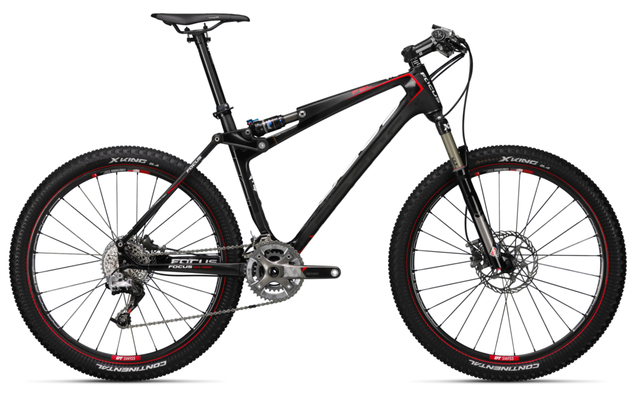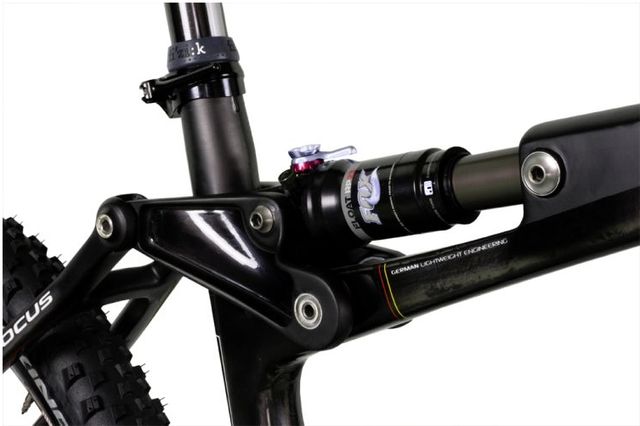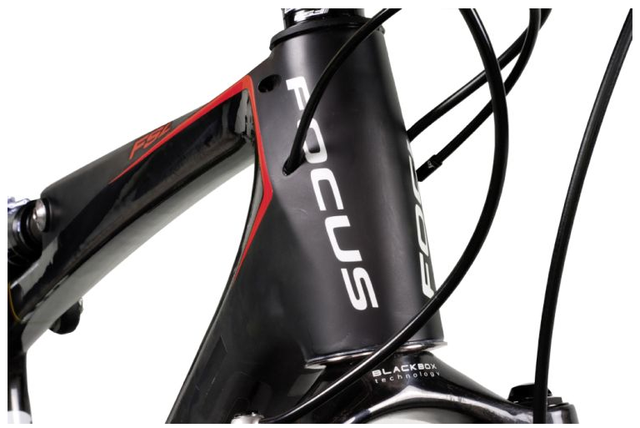This German race machine is plenty fast and light but still left us wanting.

It’s not often that a brand new suspension design shows up, so as soon as we saw the Focus FSL, we knew we had to ride it. showed a prototype of this 100mm, 26-inch-wheeled model at Interbike 2010, but because of production and stock issues we didn’t get our tester until nearly a year later. The bike was officially on the market in 2011 but pretty hard to find, meaning that 2012 is the first time that consumers will have easy access to the FSL.
THE FRAME
The FSL’s most striking feature is the top-tube mounted shock, which together with a nicely machined carbon swing-arm has a neat, trim look and feel. Focus says the design helps dampen the ride by distributing the force of impacts directly into the frame, and we’d agree that together with the Fox Float RP23 shock and , the bike easily soaked up the small bumps and quieted trail chatter. We also liked that the toggle switch and the shock was front and center, making it easy to switch ProPedal on and off. The design has the added benefit of leaving the main triangle clear for two water bottles, a huge boon for marathon-style racing. Other frame niceties include a Press Fit 30 bottom bracket, a tapered head tube, post-mount rear brakes on the seatstays that accommodate both 160mm and 180mm rotors, and very clean internal cable routings for derailleur cables, brakes, and even seat post and shock remote if you opt for them. In general, the frame is extremely appealing, with a huge amount of shaping, an assymetric seatpost, and oversize headtube, BB shell, and chainstays.
All that adds up to an extremely stiff frame, and the FSL was easily one of the most efficient pedaling full-suspension bikes we rode this year. , with a 69.5-degree head tube angle and relatively short wheelbase, added to the bike’s quick, sharp feeling. And at an impressive 21.2 pounds for our size medium tester, the FSL was the the lightest full suspension bike we tried鈥攁nd it felt like it. We motored up dirt roads like we were on a road bike and carved through the tightest singletrack as quick as any hardtail. The FSL is billed as a race bike, and its machine gun-fast handling and pedaling definitely fit that bill.

However, we did have some gripes with the suspension design. Though we liked the placement of the shock for ease of on-the-go adjustment, a few riders complained that the swingarm rubbed the inside of their thighs and everyone found that the RP23’s聽toggle switch had an annoying tendency to catch and snag on baggy shorts. More importantly, the suspension was difficult to get right, and lots of micro-adjustments to the shock pressure still left us feeling like we either had too much air (i.e. we couldn’t get all the travel) or too little (because the shock bottomed). Even with sag set properly, the rear end had a very on-or-off feel, and that stiff, efficient sensation that we liked so much for pedaling meant jangly descents were not all plush. Too often, we just got pinged around in rocky terrain.
THE PARTS
As expected on a bike this expensive, the spec was all top shelf, with a full SRAM XX drivetrain and brakes, feathery, and carbon cockpit bits and pieces from 3T. All worked pretty much as expected鈥攊.e. very well鈥攖hough we continue to have spotty results with the XX brakes. The front one on this pair worked sporadically and needed constant bleeding, which reinforces our feeling that SRAM’s second-tier XO brakes are more reliable than the superlight but spendy XX version. The double chainring up front (42-28) seemed stout at first, but given the bike’s lack of heft, it proved perfect and we never felt over geared.

The DT wheels were incredibly stiff for as light as they are (sub-three pounds for the pair), and we were surprised with how hard we could push them in corners without any sensation of flex. They even stood up to rubbly, rough terrain and showed no signs of chipping or abuse even after nine months of reasonably hard riding. One niggle: Given the cost of the FSL, we wish the DT tubeless conversion kit was included. But that’s a complaint we have with many high-end bikes these days: For this kind of money, you should get the ride exactly as you want it.
A few testers weren’t keen on the flat bars, but they suit the FSL’s race-orientation and contributed to the fast feel. We also heard a bit of grousing about the 3T Doric carbon seat post, which looks and feels great once you have it set up but is fiddly when switching out saddles. As always, the Continental XKing tires were supple and smooth tracking, and we appreciated the 2.4-inch girth for the extra cushion, but the pliable sidewalls didn’t take long to shred in our rocky, southwest test loops. And finally, while we liked the feel of the Fi’zik leather grips, they were a strange (and heavy) choice on such a weight-weenie, race-ready ride.
THE BOTTOM LINE
We’re left feeling a bit conflicted about the FSL 1.0. On one hand, it is a true rocket that we happily raced at numerous XC events, and several riders found the tight-fitting cockpit just right for fast, hard riding. The build quality is top notch, the parts are rock solid, and the bike is generally sexy as hell. Having said that, the $9,700 price tag (revised downward to , with a bit of a different spec) is steep, especially given our ambivalence about the feel of the rear end. , which mates the same frame to still high-end XT parts, is a much better value at $4,750 (though still hardly a bargain) and would make a blazing fast race bike for those seeking something exotic.
In the end, we can’t help but feel that the FSL is a good bike just waiting to come of age in the form of a 29er. This hyper-efficient platform would pair perfectly with bigger wheels and would contend for the title of ultimate endurance racer. European manufacturers have been slow to get on the 29er bandwagon, so it might be a while before we get to test out that theory.
–Aaron Gulley